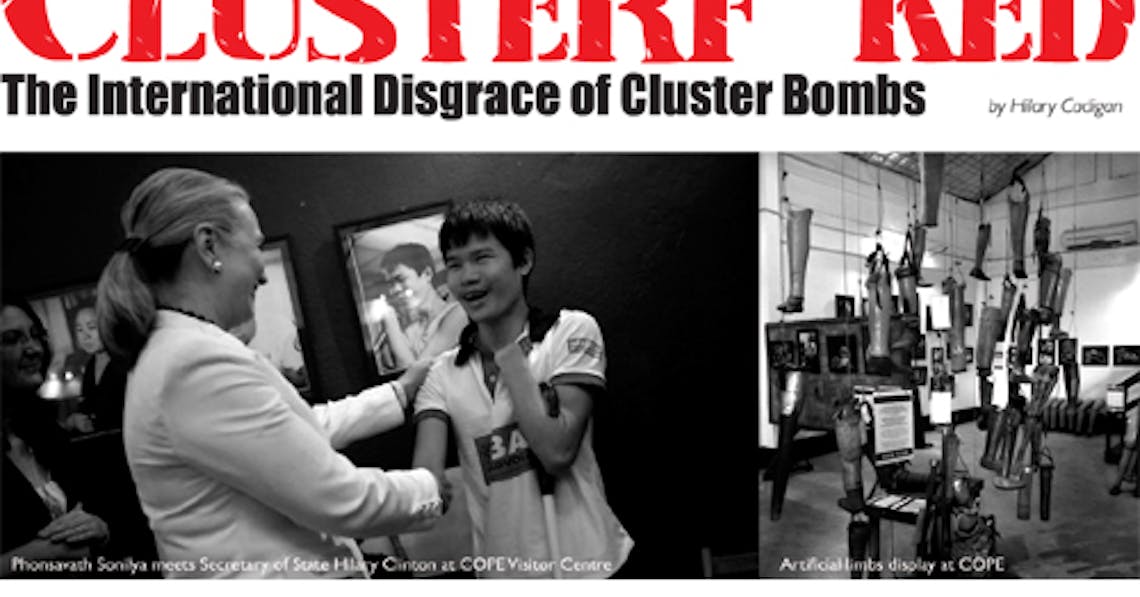During my tour of the COPE Visitor Centre in Vientiane, Laos, I met a young man named Phonsavath Sonilya, age 19. Phonsavath lost both his hands and his sight three years ago from the blast of a UXO, which stands for Unexploded Ordinances, a.k.a. cluster bombs left behind from the Vietnam War. He couldn’t see me but sensed I was there and, smiling, asked for my name. When I told him, he responded with the usual, “Oh, like Hillary Clinton,” (seriously, everyone I meet says this), followed by the not-so-usual, “I met her a few months ago!”
Indeed, Ms. Clinton took a trip to Vientiane this past summer, marking the first visit to Laos by an American secretary of state in 57 years. She too toured the COPE Visitor Centre, met Phonsavath, and listened to his story. Unlike mine, her visit was documented and photographed by the New York Times, where she was quoted as calling the experience “a painful reminder of the Vietnam War era.”
What is wrong with this heartwarming picture? The fact that the US still uses cluster bombs. I applaud Secretary Clinton for visiting, but, like Phonsavath and many other victims of UXO explosions, I want to know: why oh why hasn’t the United States Government done anything to rectify the truly appalling situation in Laos PDR?
Coping with Cluster Bombs
I’ll be honest; before my visa run to Vientiane, I knew very little about UXOs and the leading role my home country, the good old US of A, plays in their dissemination. But upon entering the COPE Visitor Centre, that all changed, and over the next few months I found myself digging through evidence of what I can only describe as an international disgrace, hidden in plain sight and yet largely unnoticed or ignored by the general public.
COPE stands for the Cooperative Orthotic and Prosthetic Enterprise. According to their website, “COPE is a Lao not-for-profit organisation that works with the government-run National Rehabilitation Centre (NRC) in an innovative partnership developing rehabilitation services across Lao PDR.” The services they offer include the provision of prosthetic limbs and supportive devices (such as braces and wheelchairs) as well as physical and occupational therapy to teach prostheses recipients how to use their new limbs. COPE will cover the cost of devices, surgery, treatment, transport, and therapy for anyone who cannot afford to pay, as well as providing a daily allowance for patients and their caretakers.
In addition, COPE seeks to raise awareness of both the availability of their services and the chilling reasons behind why the work they do is so necessary.
The most common reason people require prosthetics in Laos is due to injuries cause by cluster bombs left behind from 1960s-1970s wartime. In fact, per capita, Laos PDR is the most heavily bombed country in the world-more so than Germany and Japan during World War II combined. During the Second Indochina War, the US Air Force dropped a planeload of bombs every eight minutes for nine years.
As the Associated Press points out, “Cluster bombs are of particular concern because they scatter small bomblets over a wide area. Many bomblets do not immediately explode, posing a threat to civilians for long afterward.” In fact, the estimated failure rate for these submunitions is 30%, meaning that nearly a third of the over 260 million bomblets dropped on Laos did not explode on impact, and have therefore remained peppered throughout the country’s soil as de facto landmines, which can blow up at any given time.
The most shocking statistic of all? According to global aid organisation Handicap International, 98% of recorded cluster bomb victims are civilians. Of these, 27% are children.

Boun’s Story
Today, nearly 40 years after the war ended, rural Laos remains a very dangerous place. According to the Lao National Regulatory Authority for UXO (NRA), 41 of the 47 poorest districts nationwide are still contaminated with UXO. The ‘bombies’, as the locals call them, are particularly concentrated in rural areas, detonate under heat, and look like toys. As such, farmers sowing their fields, families cooking their food, and children playing in their yards are at particularly high risk. Annually, at least 300 people are killed or injured as a result of UXOs.
This is what happened to Boun, a 27-year-old monk living in Vientiane Province. When Boun was just 11 years old, he and three of his friends were playing near their village in Tolakhorm when they discovered a bombie lying on the ground. Lacking any knowledge of the dangers of UXOs, the young boys thought they might be able to use the explosive material to build a toy rocket. As they attempted to dismantle the bombie, it went off, destroying Boun’s arm and one of his eyes. His friend was killed instantly.
Boun lived for 16 years without an arm, until he found out about COPE from a fellow villager. In July of 2012, the organisation provided him with his very first prosthetic, free of charge. “Now I have arms like normal people and I am so confident participating in Buddhist activities,” says Boun. “It has changed my life a lot.”
However, Boun is still well-aware of the injustice that befell him 16 years ago, as shown by his heartfelt appeal to President Obama. “May I take the chance to remind you that the unexploded ordnances of the war that ended nearly 40 years ago in Laos still kill and maim people,” he says. “I don’t want more people to be like me. We need your support to make our land safe for the local people.”
According to a 2010 report published jointly by UXO Lao and the NRA, which surveyed 94% of Lao households, an estimated 20,000 people have died from UXOs since the war ended in 1975. As Maligna Saignavongs, the retired head of the NRA and Laos’ chief negotiator for the Convention on Cluster Munitions, told the Asia Times, it is actually quite possible that figures could be even higher. “In the remote areas, many people simply bleed out and die, their bodies eaten by animals. Their families may not know they died from UXO,” she said.

The Treaty (Or Not)
Not only is America responsible for a great deal of the death and destruction wrought upon tiny Laos in the past, but it is also glaringly missing from the Convention on Cluster Munitions Treaty, an international agreement to prohibit the use, transfer and stockpile of cluster bombs. At present, 111 countries have signed the international treaty, including Laos, the UK and most of Europe. The United States, however, along with China, Russia, India, Israel, Pakistan, Brazil, and other heavily armed countries, has decided that they should not only be allowed to stockpile these dangerous weapons, but also use them whenever they see fit.
Yes, that’s right. Despite the appalling statistics, these heavily armed world powers have continued dropping cluster bombs in recent years, including Israel’s enormous 2006 bombing campaign in Lebanon and America’s secret cruise missile attack on Yemen in 2009. Hundreds of civilian casualties ensued.
It gets worse. Not only has the US refused to sign the treaty and continued to use cluster bombs. According to The Independent, they’ve also made attempts to derail it altogether. “The UK Government is supporting a Washington-led proposal that would permit the use of cluster bombs as long as they were manufactured after 1980 and had a failure rate of less than 1%,” wrote Independent correspondent Jerome Taylor in November 2011. “Arms campaigners say the 1980 cut-off point is arbitrary, and that many modern cluster bombs have far higher failure rates on the field of battle than manufacturers claim.”
Thailand is mysteriously missing from the list of signatories as well, and was recently accused of using cluster munitions in an attack on Cambodian territory as recently as last year, according to the Bangkok Post.
All in all, when it comes to cluster bombs, it’s often a game of accusations and denials. Most recently, in October of 2012, Syria’s usage of cluster bombs was reported by international non-governmental organisation Human Rights Watch, along with the statement: “Syria’s disregard for its civilian population is all too evident in its air campaign, which now apparently includes dropping these deadly cluster bombs into populated areas.”
So why, with the usage of cluster bombs deemed wholly unacceptable by human rights groups on a global scale, does the military continue to use them?
US Policy
According to the US State Department’s website, “the United States shares in the international concern about the humanitarian impact of all munitions, including cluster munitions. That is one of the reasons that it spends more than any other country to eliminate the risk to civilians from landmines and all explosive remnants of war, including unexploded cluster munitions. That is also why the United States strongly supports negotiations on cluster munitions within the framework of the Convention on Conventional Weapons.”
It’s true that the US has made some moves toward reparation, but COPE’s research shows that between 1993 and 2010, the US government, corporations and private foundations gave less than $40 million for UXO clean-up. This isn’t nothing, but as Melody Kemp of the Asia Times points out, it is “a trifling sum compared with the billions it has allocated for its new generation of wars.”
America has also designed various policies intended to hold cluster bombs to new safety standards, but refuses to simply outlaw them altogether, insisting that “cluster munitions have demonstrated military utility. Their elimination from U.S. stockpiles would put the lives of its soldiers and those of its coalition partners at risk. Moreover, cluster munitions can often result in much less collateral damage than unitary weapons, such as a larger bomb or larger artillery shell would cause, if used for the same mission.”
But where are the statistics to prove this? And how does a weapon whose victims are 98% innocent civilians provide any sort of military utility, other than instilling rampant fear into the communities we choose to target? Maybe it’s time we all start demanding some answers.
To learn more about COPE or donate to their cause, please visit: www.copelaos.org
